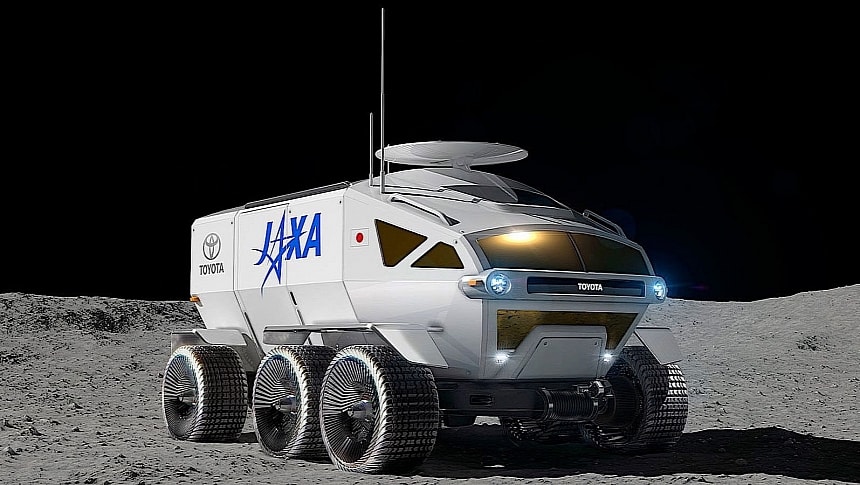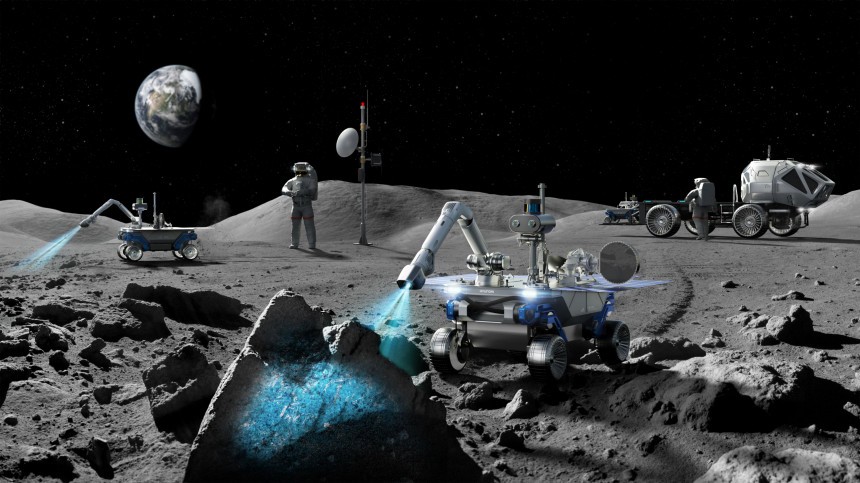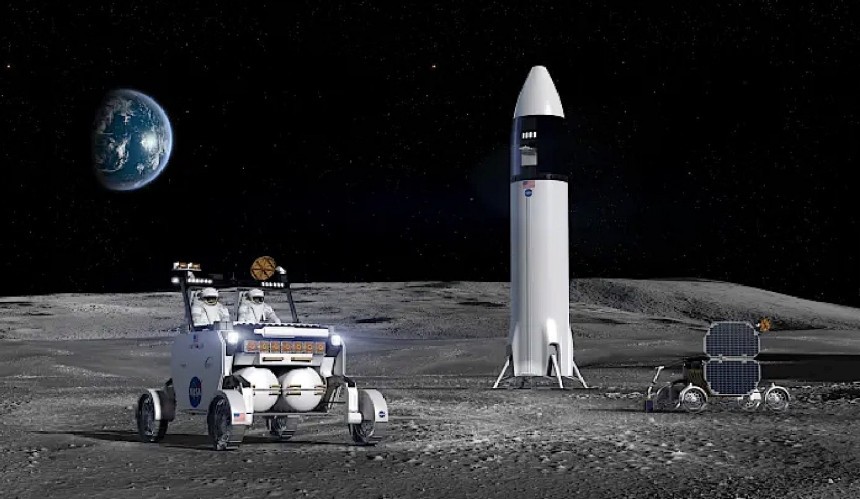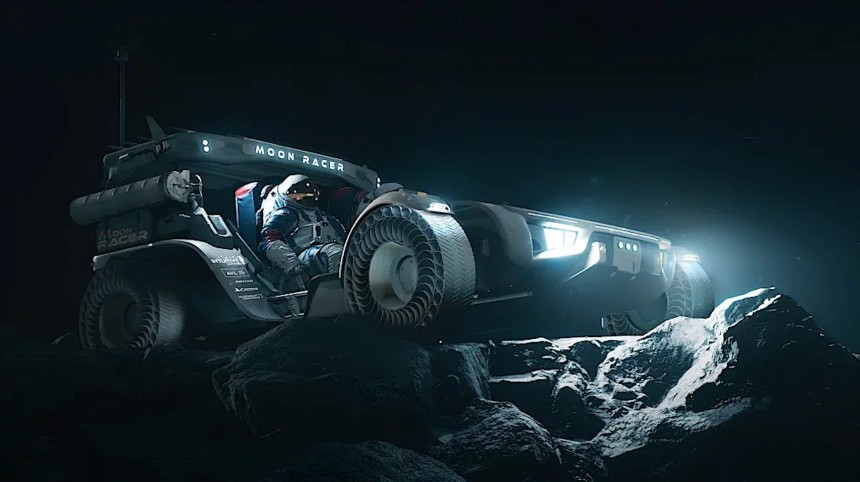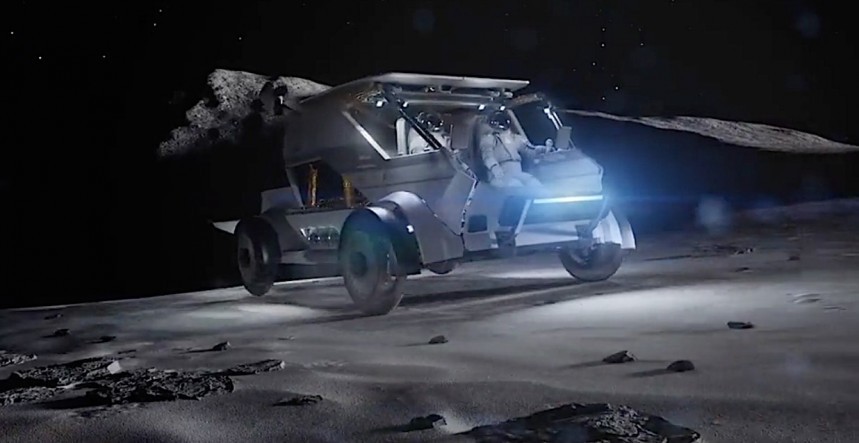In the not-so-distant future the carmakers of Earth will have a choice to make: keep doing what they've always been doing (which is manufacture cars for the people of Earth), or expand their offering to include cars, SUVs, and trucks meant to be driven on other worlds. Do you think I'm exaggerating? Read on.
Humanity is at the moment engaged in space exploration efforts of a magnitude never seen before, not even in the glory years that became known as the Space Race era. That's because, unlike before, governments are no longer alone in this, but have been joined by a small army of private companies whose sole purpose on this Earth is to make money from exploiting space and the surrounding planets.
We now have plans to colonize the Moon with the help of the NASA and private industry-backed Artemis program, missions to Mars are being drawn up in a room somewhere, several orbital space stations are being planned, and efforts are being made to send missions to the distant worlds of our solar system.
Exciting and new as they may seem, the worlds humanity is about to unlock for itself will probably be governed by the same rules and habits we've grown accustomed to here on Earth. We'll eat the same food, have fun in the same way, and move ourselves over alien terrain in the same fashion.
Over the years we've had a close look at pretty much all of the plans NASA, its private partners, and the larger world have for space exploration. But until now we've never really compiled a list of the land-going vehicles being cooked up around the world to move people and cargo on the Moon, Mars, and elsewhere.
We kind of got a taste for it in early April, when NASA announced the final three companies competing for the honor of making the crew-rated Moon rover for the upcoming Artemis missions, under the so-called Lunar Terrain Vehicle (LTV) program.
The vehicles you're about to read in the lines below are, for all intents and purposes, the precursors of humanity's alien cars, but they will not be, not in the slightest, the only ones that will be envisioned over the years for extraterrestrial use.
Remember how I started all this by saying carmakers will have a choice to make when it comes to expanding their offering to include off-world vehicles? Well, as you'll see below, some of them have already made the choice.
Nissan's design was simply called Moon Rover, and it was to be put together with help from private companies Teledyne Brown Engineering and Sierra Space – combining efforts is, as you'll see below, a defining trait of efforts to make extraterrestrial cars.
The design was meant to be an entry in the LTV program competition, and that means it would have followed the requirements NASA set forth for the machine.
As per the details of the deal between the three companies, Teledyne was tasked with engineering and manufacturing the rover and its systems. On its end, Sierra Space was in charge of making the flight software, space-qualified mechanisms, communications, pointing, navigation, and timing.
Nissan's actual role in the project was never truly detailed beyond the fact the carmaker would have brought on board ±deep knowledge into autonomous driving and intelligent vehicle systems."
NASA did not select Teledyne and its partners to continue in the LTV program, but that doesn't mean it won't eventually land something on Earth's satellite. The carmaker is separately in cahoots with the Japanese Space Agency (JAXA) for the development of an uncrewed Moon rover - the one shown in the video above. Its exact status at the time of writing is unknown.
Back in 2023 Toyota announced a joint project being run with Japanese Space Agency JAXA. The goal of the collab is simple: create a pressurized vehicle (meaning people will be able to ride in it with no suits on) for use on the Moon.
The vehicle is called Lunar Cruiser in a not-so-subtle nod to the Land Cruiser that made the carmaker famous the world over. Compared to what others have planned, including NASA, this thing could possibly be the undisputed champion of extraterrestrial vehicles.
The Lunar Cruiser is being imagined as a hydrogen electric vehicle, meaning its range would dwarf anything else available, "even with the limited amount of energy that can be transported to the Moon."
Using tech inspired by the Toyota Mirai, the vehicle should be able to cover a total distance of 6,200 miles (almost 10,000 km), provided, of course, anyone would dare venture that far.
The Lunar Cruiser is gigantic compared to the two-person LTV - it is about the size of two minibusses standing side by side. Yet its interior pressurized volume is just 459 cubic feet (13 cubic meters), which is only enough for two people, or four of them in extreme emergency situations.
After sharing the initial details of the project Toyota didn't say anything else about the Lunar Cruiser. This week, however, NASA itself announced a partnership with JAXA aimed at developing "a pressurized rover for crewed and uncrewed exploration on the Moon." The two organizations don't specifically name Toyota, but how many pressurized rovers do you know about?
South Korea may not exactly be at the forefront of space exploration, but it certainly is at the top of the pack when it comes to carmaking. And it would be a waste of talent for giants like Hyundai and Kia not to use their expertise to create a Moon rover.
About a year ago, Hyundai announced it had entered a project to build "a development model of a lunar exploration rover." The company is working on this with no less than six Korean research institutes that operate in the aerospace, telecommunications, and atomic energy sectors.
The rover, which at the moment does not have an official name, will use robotics and autonomous driving technologies developed for Hyundai and Kia cars. As far as we can tell, the initial version of the machine, which will weigh just 154 pounds (70 kg), is not meant to carry people, only scientific payloads.
No other details are known at the moment. The South Koreans are planning to complete a test unit in the second half of this year, and target a potential Moon launch sometime in 2027.
And now come the three vehicles NASA chose for the LTV program. Because all of them must share the same capabilities , let's go through the requirements of the LTV beforehand.
The vehicle is to be designed as an unpressurized machine, meaning it will have to be able to carry a crew of two astronauts wearing their spacesuits. Cargo for science missions and whatnot would also have to fit, up to a total weight of 500 kg (1,100 pounds) of cargo, astronauts included. A robotic arm for loading and unloading stuff has to be included, as well as a navigation console to allow the astronauts to orient themselves in the unknown environment.
The vehicle will have to be powered by an electric drivetrain that should be made in such a way as to survive the extreme temperatures experienced on the surface of the Moon, which generally range from 280 to minus 280 degrees Fahrenheit (138 to minus 173 degrees Celsius).
One of the companies NASA selected earlier in April to move forward with the LTV design is Venturi Astrolab. You might know the name as Venturi is also in the business of making limited-production race cars, including the MVS Venturi, the Atlantique, or the LM.
Astrolab, the crew's American division, teamed up for the lunar rover project with Axiom Space and Odyssey Space Research, both of them very present names in the space news sections of publications from all over the world.
By itself, Venturi Astrolab seems to be a very imaginative business, as it has in its portfolio some very wacky terrestrial vehicles with even wackier names: Fetish, Eclectic, or America. And its proposition for the LTV program is equally as insane.
The vehicle is called Flexible Logistics and Exploration, or FLEX for short. It is the strangest of the entire bunch of three vehicles NASA selected, not in small part to its very small wheels, the very elevated position astronauts are driving in, and the quirky shape of the rover's body. But it does have a few things going for it, and that's why both the American space agency noticed it.
The first thing would be the aforementioned wheels. Small as they are, they are hyper-deformable, meaning they change their shape to adapt to the particularities of the lunar terrain. Helping them do that are no less than 192 cables that act as spokes, but also springs installed on the outer rims.
The second thing the FLEX has and the others don't is a working prototype. Venturi Astrolab presented the deformable wheels at the Paris Air Show in 2023, and tested a prototype of the rover both in the lab and in the field for thousands of hours.
At this point in time it's unclear whether FLEX is the rover NASA will decide to use for the Artemis program, but even if it doesn't, given the ever-expanding space industry, chances are someone, somewhere, will find a use for it.
Intuitive Machines is a company that made it into the history books earlier this year as the first private American company to set down a lander on the surface of the Moon. The hardware is called Odysseus, and it has helped NASA and private partners test crucial technologies that will help the Artemis Moon exploration program.
The company's skills as a maker of solid gear for space exploration were confirmed once more by NASA when Intuitive Machines' Moon rover made it into the new phase of the LTV program. The vehicle is called Reusable Autonomous Crewed Exploration Rover, or RACER.
The effort to make it is shared with several high-profile companies in the aerospace and automotive industries, including AVL, Boeing, Michelin, and Northrop Grumman.
Boeing, which together with General Motors worked on the Lunar Roving Vehicles used during the Apollo missions, is tasked with mission planning and the operation of the machine, while Northrop Grumman will develop the electric drivetrain.
The steering and the suspension systems of the RACER are the responsibility of AVL, with Michelin tasked with supplying the tires that are meant to survive the harsh conditions on the Moon. On its end, Intuitive Machines will handle systems integration, spacecraft design, energy management, avionics, autonomous navigation, sensors, controls, mission planning, and operations.
Even if NASA ends up picking another vehicle than the RACER (a quite fitting acronym, given the thing's shape as revealed in the single rendering released so far), it's likely the rover will be used on the Moon for Intuitive Machines' own missions.
The final entry in NASA's quest for an Artemis Moon rover is the Lunar Dawn. I'm talking about a design put together by space startup Lunar Outpost with help from Lockheed Martin, General Motors, The Goodyear Tire and Rubber Company, and MDA Space.
Just like with the previous two entries, the Lunar Dawn will come to be as a collaborative effort between some of the biggest names in business, like Lockheed Martin, General Motors, The Goodyear Tire and Rubber Company, and MDA Space.
Not all the roles of these companies in the project have been detailed (for instance, it's unclear what aerospace giant Lockheed Martin is contributing), but it's easy to imagine Goodyear working on the tires and MDA Space contributing the robotics.
The biggest contribution, in my view (and by all intents and purposes the only one of a major carmaker to the LTV effort), is that of GM. The automotive behemoth will supply the battery pack for the rover's electric drivetrain. And that battery pack is, naturally, part of the Ultium family.
The technology came about in 2020 and has ended up powering a number of GM, Acura, and Honda vehicles (but not as many as GM would have liked by this point in time). The exact capabilities of the Ultium system in the Lunar Dawn rover are not known at the time of writing.
We now have plans to colonize the Moon with the help of the NASA and private industry-backed Artemis program, missions to Mars are being drawn up in a room somewhere, several orbital space stations are being planned, and efforts are being made to send missions to the distant worlds of our solar system.
Exciting and new as they may seem, the worlds humanity is about to unlock for itself will probably be governed by the same rules and habits we've grown accustomed to here on Earth. We'll eat the same food, have fun in the same way, and move ourselves over alien terrain in the same fashion.
Over the years we've had a close look at pretty much all of the plans NASA, its private partners, and the larger world have for space exploration. But until now we've never really compiled a list of the land-going vehicles being cooked up around the world to move people and cargo on the Moon, Mars, and elsewhere.
We kind of got a taste for it in early April, when NASA announced the final three companies competing for the honor of making the crew-rated Moon rover for the upcoming Artemis missions, under the so-called Lunar Terrain Vehicle (LTV) program.
The vehicles you're about to read in the lines below are, for all intents and purposes, the precursors of humanity's alien cars, but they will not be, not in the slightest, the only ones that will be envisioned over the years for extraterrestrial use.
Remember how I started all this by saying carmakers will have a choice to make when it comes to expanding their offering to include off-world vehicles? Well, as you'll see below, some of them have already made the choice.
Teledyne Brown Engineering Moon Rover (with Nissan)
Among the first carmaking companies to jump onboard the Moon rover train was Japanese Nissan, or more specifically its North American branch. Back in 2022, at a time when NASA was still getting ready for the launch of its first-ever Artemis mission, the Japanese announced their interest in designing a rover for the later flights of the program.Nissan's design was simply called Moon Rover, and it was to be put together with help from private companies Teledyne Brown Engineering and Sierra Space – combining efforts is, as you'll see below, a defining trait of efforts to make extraterrestrial cars.
The design was meant to be an entry in the LTV program competition, and that means it would have followed the requirements NASA set forth for the machine.
As per the details of the deal between the three companies, Teledyne was tasked with engineering and manufacturing the rover and its systems. On its end, Sierra Space was in charge of making the flight software, space-qualified mechanisms, communications, pointing, navigation, and timing.
Nissan's actual role in the project was never truly detailed beyond the fact the carmaker would have brought on board ±deep knowledge into autonomous driving and intelligent vehicle systems."
NASA did not select Teledyne and its partners to continue in the LTV program, but that doesn't mean it won't eventually land something on Earth's satellite. The carmaker is separately in cahoots with the Japanese Space Agency (JAXA) for the development of an uncrewed Moon rover - the one shown in the video above. Its exact status at the time of writing is unknown.
Toyota Lunar Cruiser
Here on Earth, Japanese carmaker Toyota has either led the automotive industry or trailed right behind main rival Volkswagen for years now. This kind of makes us more than confident its presence will be felt on the Moon and perhaps even beyond as well.Back in 2023 Toyota announced a joint project being run with Japanese Space Agency JAXA. The goal of the collab is simple: create a pressurized vehicle (meaning people will be able to ride in it with no suits on) for use on the Moon.
The vehicle is called Lunar Cruiser in a not-so-subtle nod to the Land Cruiser that made the carmaker famous the world over. Compared to what others have planned, including NASA, this thing could possibly be the undisputed champion of extraterrestrial vehicles.
The Lunar Cruiser is being imagined as a hydrogen electric vehicle, meaning its range would dwarf anything else available, "even with the limited amount of energy that can be transported to the Moon."
Using tech inspired by the Toyota Mirai, the vehicle should be able to cover a total distance of 6,200 miles (almost 10,000 km), provided, of course, anyone would dare venture that far.
The Lunar Cruiser is gigantic compared to the two-person LTV - it is about the size of two minibusses standing side by side. Yet its interior pressurized volume is just 459 cubic feet (13 cubic meters), which is only enough for two people, or four of them in extreme emergency situations.
After sharing the initial details of the project Toyota didn't say anything else about the Lunar Cruiser. This week, however, NASA itself announced a partnership with JAXA aimed at developing "a pressurized rover for crewed and uncrewed exploration on the Moon." The two organizations don't specifically name Toyota, but how many pressurized rovers do you know about?
Hyundai Lunar Exploration Rover
About a year ago, Hyundai announced it had entered a project to build "a development model of a lunar exploration rover." The company is working on this with no less than six Korean research institutes that operate in the aerospace, telecommunications, and atomic energy sectors.
The rover, which at the moment does not have an official name, will use robotics and autonomous driving technologies developed for Hyundai and Kia cars. As far as we can tell, the initial version of the machine, which will weigh just 154 pounds (70 kg), is not meant to carry people, only scientific payloads.
No other details are known at the moment. The South Koreans are planning to complete a test unit in the second half of this year, and target a potential Moon launch sometime in 2027.
And now come the three vehicles NASA chose for the LTV program. Because all of them must share the same capabilities , let's go through the requirements of the LTV beforehand.
The vehicle is to be designed as an unpressurized machine, meaning it will have to be able to carry a crew of two astronauts wearing their spacesuits. Cargo for science missions and whatnot would also have to fit, up to a total weight of 500 kg (1,100 pounds) of cargo, astronauts included. A robotic arm for loading and unloading stuff has to be included, as well as a navigation console to allow the astronauts to orient themselves in the unknown environment.
The vehicle will have to be powered by an electric drivetrain that should be made in such a way as to survive the extreme temperatures experienced on the surface of the Moon, which generally range from 280 to minus 280 degrees Fahrenheit (138 to minus 173 degrees Celsius).
Venturi Astrolab Flexible Logistics and Exploration (FLEX)
Astrolab, the crew's American division, teamed up for the lunar rover project with Axiom Space and Odyssey Space Research, both of them very present names in the space news sections of publications from all over the world.
By itself, Venturi Astrolab seems to be a very imaginative business, as it has in its portfolio some very wacky terrestrial vehicles with even wackier names: Fetish, Eclectic, or America. And its proposition for the LTV program is equally as insane.
The vehicle is called Flexible Logistics and Exploration, or FLEX for short. It is the strangest of the entire bunch of three vehicles NASA selected, not in small part to its very small wheels, the very elevated position astronauts are driving in, and the quirky shape of the rover's body. But it does have a few things going for it, and that's why both the American space agency noticed it.
The first thing would be the aforementioned wheels. Small as they are, they are hyper-deformable, meaning they change their shape to adapt to the particularities of the lunar terrain. Helping them do that are no less than 192 cables that act as spokes, but also springs installed on the outer rims.
The second thing the FLEX has and the others don't is a working prototype. Venturi Astrolab presented the deformable wheels at the Paris Air Show in 2023, and tested a prototype of the rover both in the lab and in the field for thousands of hours.
At this point in time it's unclear whether FLEX is the rover NASA will decide to use for the Artemis program, but even if it doesn't, given the ever-expanding space industry, chances are someone, somewhere, will find a use for it.
Intuitive Machines Reusable Autonomous Crewed Exploration Rover (RACER)
The company's skills as a maker of solid gear for space exploration were confirmed once more by NASA when Intuitive Machines' Moon rover made it into the new phase of the LTV program. The vehicle is called Reusable Autonomous Crewed Exploration Rover, or RACER.
The effort to make it is shared with several high-profile companies in the aerospace and automotive industries, including AVL, Boeing, Michelin, and Northrop Grumman.
Boeing, which together with General Motors worked on the Lunar Roving Vehicles used during the Apollo missions, is tasked with mission planning and the operation of the machine, while Northrop Grumman will develop the electric drivetrain.
The steering and the suspension systems of the RACER are the responsibility of AVL, with Michelin tasked with supplying the tires that are meant to survive the harsh conditions on the Moon. On its end, Intuitive Machines will handle systems integration, spacecraft design, energy management, avionics, autonomous navigation, sensors, controls, mission planning, and operations.
Even if NASA ends up picking another vehicle than the RACER (a quite fitting acronym, given the thing's shape as revealed in the single rendering released so far), it's likely the rover will be used on the Moon for Intuitive Machines' own missions.
Lunar Outpost Lunar Dawn (with General Motors)
Just like with the previous two entries, the Lunar Dawn will come to be as a collaborative effort between some of the biggest names in business, like Lockheed Martin, General Motors, The Goodyear Tire and Rubber Company, and MDA Space.
Not all the roles of these companies in the project have been detailed (for instance, it's unclear what aerospace giant Lockheed Martin is contributing), but it's easy to imagine Goodyear working on the tires and MDA Space contributing the robotics.
The biggest contribution, in my view (and by all intents and purposes the only one of a major carmaker to the LTV effort), is that of GM. The automotive behemoth will supply the battery pack for the rover's electric drivetrain. And that battery pack is, naturally, part of the Ultium family.
The technology came about in 2020 and has ended up powering a number of GM, Acura, and Honda vehicles (but not as many as GM would have liked by this point in time). The exact capabilities of the Ultium system in the Lunar Dawn rover are not known at the time of writing.
